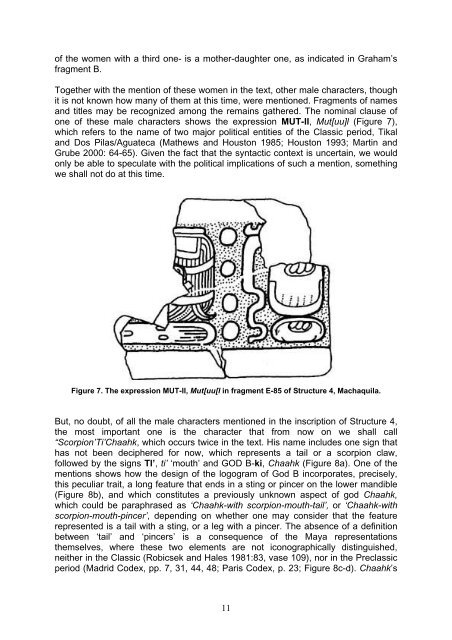63 an epigraphic account related to structure 4 at ... - Famsi
63 an epigraphic account related to structure 4 at ... - Famsi
63 an epigraphic account related to structure 4 at ... - Famsi
You also want an ePaper? Increase the reach of your titles
YUMPU automatically turns print PDFs into web optimized ePapers that Google loves.
of the women with a third one- is a mother-daughter one, as indic<strong>at</strong>ed in Graham’s<br />
fragment B.<br />
Together with the mention of these women in the text, other male characters, though<br />
it is not known how m<strong>an</strong>y of them <strong>at</strong> this time, were mentioned. Fragments of names<br />
<strong>an</strong>d titles may be recognized among the remains g<strong>at</strong>hered. The nominal clause of<br />
one of these male characters shows the expression MUT-II, Mut[uu]l (Figure 7),<br />
which refers <strong>to</strong> the name of two major political entities of the Classic period, Tikal<br />
<strong>an</strong>d Dos Pilas/Agu<strong>at</strong>eca (M<strong>at</strong>hews <strong>an</strong>d Hous<strong>to</strong>n 1985; Hous<strong>to</strong>n 1993; Martin <strong>an</strong>d<br />
Grube 2000: 64-65). Given the fact th<strong>at</strong> the syntactic context is uncertain, we would<br />
only be able <strong>to</strong> specul<strong>at</strong>e with the political implic<strong>at</strong>ions of such a mention, something<br />
we shall not do <strong>at</strong> this time.<br />
Figure 7. The expression MUT-II, Mut[uu[l in fragment E-85 of Structure 4, Machaquila.<br />
But, no doubt, of all the male characters mentioned in the inscription of Structure 4,<br />
the most import<strong>an</strong>t one is the character th<strong>at</strong> from now on we shall call<br />
“Scorpion’Ti’Chaahk, which occurs twice in the text. His name includes one sign th<strong>at</strong><br />
has not been deciphered for now, which represents a tail or a scorpion claw,<br />
followed by the signs TI’, ti’ ‘mouth’ <strong>an</strong>d GOD B-ki, Chaahk (Figure 8a). One of the<br />
mentions shows how the design of the logogram of God B incorpor<strong>at</strong>es, precisely,<br />
this peculiar trait, a long fe<strong>at</strong>ure th<strong>at</strong> ends in a sting or pincer on the lower m<strong>an</strong>dible<br />
(Figure 8b), <strong>an</strong>d which constitutes a previously unknown aspect of god Chaahk,<br />
which could be paraphrased as ‘Chaahk-with scorpion-mouth-tail’, or ‘Chaahk-with<br />
scorpion-mouth-pincer’, depending on whether one may consider th<strong>at</strong> the fe<strong>at</strong>ure<br />
represented is a tail with a sting, or a leg with a pincer. The absence of a definition<br />
between ‘tail’ <strong>an</strong>d ‘pincers’ is a consequence of the Maya represent<strong>at</strong>ions<br />
themselves, where these two elements are not iconographically distinguished,<br />
neither in the Classic (Robicsek <strong>an</strong>d Hales 1981:83, vase 109), nor in the Preclassic<br />
period (Madrid Codex, pp. 7, 31, 44, 48; Paris Codex, p. 23; Figure 8c-d). Chaahk’s<br />
11
















